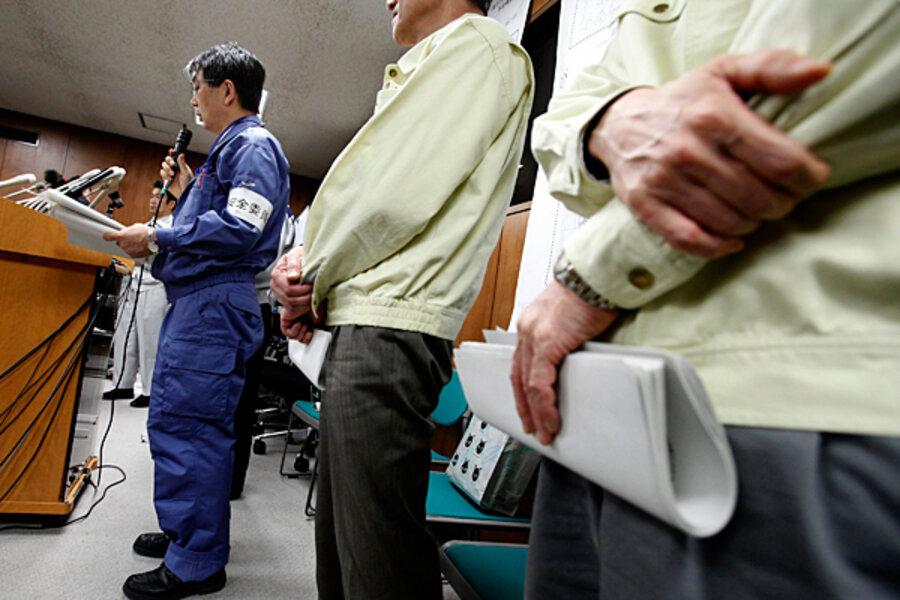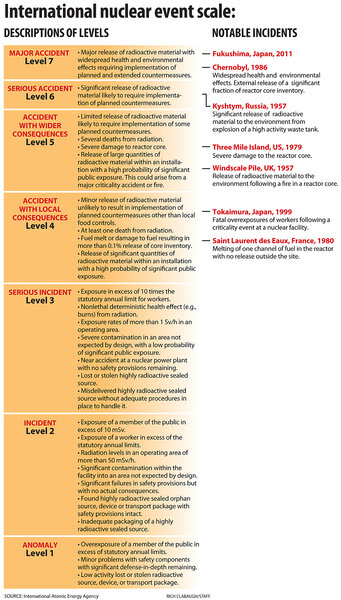How can Fukushima crisis be rated as severe as Chernobyl?
Loading...
Some specialists are questioning the usefulness of an international scale for measuring the severity of nuclear accidents – a scale that now rates the Fukushima Daiichi crisis in Japan as equal to Chernobyl.
They note that even by the most dire estimates Fukushima has released only one-tenth the radiation that Chernobyl did. Moreover, they suggest that scale is not intended to help politicians and the public decide how to act – it was designed by engineers for engineers, and is even flawed in that respect, they say.
Officials at two Japanese agencies that oversee the nuclear industry jointly announced they were elevating the severity of the crisis on the International Atomic Energy Agency's (IAEA) severity index from 5 to 7, the maximum ranking.
But the scale "doesn't trigger anything," says David Ropeik, who heads Ropeik & Associates, a risk-management consulting firm in Concord, Mass. "Here it is being used, and it's demonstrating that it can't even categorize things that precisely."
It's more than a quibble over numbers, he says. Instead, it's about uncertainty and confusion among a public already stressed by the effects to themselves and their loved ones of the quake and tsunami. "To the extent that this tool is adding to that, it's making things worse," he says.
What the scale measures
The scale was developed in Chernobyl's aftermath.
"People felt there needs to be some kind of way to explain the safety significance of events associated with radiological accidents," including events at nuclear plants, says Olli Heinonen, a senior fellow at Harvard University's Belfer Center for Science and International Affairs in Cambridge, Mass.
Each increase in the scale represents a 10-fold increase in the amount of radioactive iodine-131 released. IAEA members agreed on that benchmark because iodine-131 is among the most readily released isotopes during a reactor accident. But it also is among the fastest to decay, losing about half of its remaining radioactivity every eight days.
Actual or potential human exposures to radioactive materials released are explicitly considered in the index's first five levels, many of which have the potential to contaminate only people working at a nuclear facility.
The index doesn't specify exposures for the higher levels because the index's architects figured it would be difficult to measure that as an event unfolded. Much depends on how a government responds with evacuations, for instance, and on factors such as weather patterns, which might tend to steer plumes of radioactive material toward or away from populated areas.
Government responses to an incident – evacuations, or bans on consuming produce, dairy, and meat products from the affected region – also affect exposure, and so makes it harder to track as an event is unfolding.
The scale's flaws
But the rating system suffers from fundamental flaws that derive from the international negotiating process that spawned them, some specialists say. They are vague and so open to an individual country's interpretation.
During the early part of the Fukushima Daiichi crisis, for example, Japanese officials treated each stricken reactor as a separate incident, each with its own rating, according to IAEA officials. One reason for today's rise in the index, which the agency cautions as "provisional," is that the damage to three of the four stricken reactors now is being treated as a single event, while the fourth unit is being treated individually as a 3 on the scale.
Dr. Heinonen adds that the IAEA isn't set up to provide independent review of data the Japanese are releasing.
"There is no vetting process, which I think we have to revisit," he says.
Indeed, Mr. Ropeik argues that while the notion of having a tool to help the public understand what it's facing in an event such as this is laudable, the current tool ought to be scrapped for one that focuses more tightly on people's immediate concerns.
Like the earthquake, asteroid, and hurricane hazard scales, "scientists are trying to organize our thinking into theirs," rather than meeting the public where its thinking is as it views such hazards.
Instead, the public is likely to find more use in something that gives them the situation on any given day.
Rankings may be useful for putting an event into a general historical context, but for daily decision-making, the public is more interested in "what's the situation here, now, upwind, downwind, 50 miles away.
To people wondering what to do next, comparison with some event 43 years ago "doesn't matter," he says.






